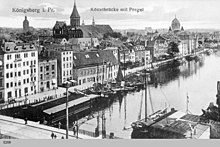Pregel
|
Pregel Прего́ля (Pregolja) |
||
| Data | ||
| Water code | RU : 01010000212104300009873 | |
| location | Kaliningrad Oblast ( Russia ) | |
| River system | Pregel | |
| confluence | von Instrutsch ( Inster ) and Angrapa ( Angerapp ) near Tschernjachowsk ( Insterburg ) 54 ° 38 ′ 53 ″ N , 21 ° 47 ′ 32 ″ E |
|
| muzzle |
Fresh lagoon (Baltic Sea) near Kaliningrad (Königsberg) Coordinates: 54 ° 41 ′ 21 ″ N , 20 ° 22 ′ 28 ″ E 54 ° 41 ′ 21 ″ N , 20 ° 22 ′ 28 ″ E |
|
| Mouth height |
0 m
|
|
| length | 123 km | |
| Catchment area | 15,500 km² | |
| Discharge at the gauge near the mouth |
MQ |
90 m³ / s |
| Left tributaries | Lawa , Baidukowka , Bobrowaya , Gwardeiskaya , Bolshaya , Golubaya | |
| Right tributaries | Lakowka , Gurjewka , Glubokaja , Gremjatschja | |
| Big cities | Kaliningrad | |
| Medium-sized cities | Chernyakhovsk | |
| Navigable | along the whole length | |
The Pregel ( Prussian Preigara and Preigile , Russian Прего́ля (Pregolja), Lithuanian Prieglius ) is a river in the Kaliningrad Oblast , the Russian part of East Prussia . It is 123 km, together with the Angerapp , one of the most important tributaries, 292 km long. Its catchment area covers 15,500 km². The mean discharge (MQ) is 90 m³ / s.
Surname
The Chronos river mentioned by Claudius Ptolemy was identified with the Pregel. During the Gothic period the Pregel was called Skara . At the time of the order (1231: Lipz) the river was also called Lipsa (1246: "Lipza"): "Lindenfluss". In 1243 it was called "flumen pregore". This name is interpreted linguistically differently: According to Peteraitis "fast, brave", according to Vanagas "hell, abyss" and according to Gerullis "groundless path, abyss". According to Preuss, the name Pregel comes from the older names Pregolla and Prigora ( prie bei and gora Berg, i.e. 'near the mountain') and is related to the fact that the source currents of the Pregel are united on one mountain. The name Pregel (Prussian “preigillis”: at the lower point) first appeared in 1302.
Course and connections with other waters
The Pregel arises west of Tschernjachowsk ( Insterburg ) from the confluence of the Instrutsch ( Inster ) and Angrapa ( Angerapp ) and flows in a westerly direction through wide plains . It has a connection to the Curonian Lagoon via the Deima ( Deime ), which branches off at Gwardeisk ( Tapiau ) and, since 1697, a connection to the Memel via the Deime and the Polesski Canal ( Großer Friedrichsgraben ) .
The river splits into two arms at Friedrichstein Castle , the Old Pregel or the Natangian Pregel and to the north of it the New Pregel or the Samland Pregel. The arms unite again around the island of Kneiphof . The bend in the lower reaches of the roller mill in Rathshof was straightened by a puncture in the 1920s.
The Pregel flows into the Fresh Lagoon behind Kaliningrad ( Königsberg ) .
Like all rivers in the Kaliningrad Oblast, the Pregel is heavily polluted by the lack of functioning sewage treatment plants (2014).
Traffic significance
The river is navigable along its entire length. The importance of this waterway had declined since the completion of the Kaliningrad – Chernyshevskoye railway (Eydtkuhnen on the Russian border) in the 19th century.
Cities on the Pregel

- Chernyakhovsk ( Insterburg )
- Znamensk ( Wehlau )
- Gwardeisk ( Tapiau )
- Kaliningrad ( Königsberg Pr. )
Main tributaries
- Lawa ( Łyna , all )
- Angrapa ( Angerapp , Węgorapa )
- Instrutsch ( Inster )
See also
Web links
Individual evidence
- ↑ a b Pregel in the State Water Directory of the Russian Federation (Russian)
- ↑ a b Article Pregel in the Great Soviet Encyclopedia (BSE) , 3rd edition 1969–1978 (Russian)
- ↑ Ptolemy 3.5.2. See also: Alfred Stückelberger, Gerd Graßhoff (eds.): Klaudios Ptolemaios: Handbuch der Geographie Schwabe, Basel 2006, 1st part, p. 299
- ↑ Reallexikon der Germanischen Altertumskunde sv; Jerzy Kolendo : Roman acquaintance with the south-east Baltic coast. The Karbones of Ptolemy. In: Barbaricum 2 (1992) pp. 186-90
- ^ August Eduard Preuss : Prussian country and folklore or description of Prussia . Koenigsberg i. Pr. 1835, p. 36.
- ^ Andreas Kurt Borm: The development of Königsberg i. Pr. On a modern city in the Weimar Republic (Diss. Univ. Greifswald 2016)
